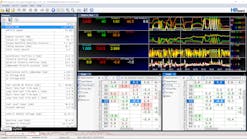An engine that stalls can present a real diagnostic challenge since a stalling engine can occur at many different loads such as; idle, light load, moderate load, and heavy load. Each of these load conditions can cause challenges when diagnosing the engine. However, in all of these conditions, if the engine stalls a failure has occurred. The question at hand is what failure caused the engine to stall?
The scan tool is the technician’s first tool choice. It gathers data that may help in the diagnosis of the stalling engine, but all too many times the scan tool is just not helpful. This is caused by many different problems scan tools exhibit.
One of these problems is that no data is live; there is a delay in all data transmissions. If a stalling problem occurs it may be so fast that this delay will hide the root cause of the stalling problem or may lead you in the wrong direction. Remember that as the engine is stalling, the entire data sets (sensor readings) are in change. As the engine is stalling, these data sets are linked together in chains that indicate the physical changes that are read by the sensors. If you see a piece of the chain in the scan tool data stream fail, this may not be the start of the chain but somewhere in the middle of the chain. With the delay that is present in all data transmissions, it may be very difficult to see the root cause.
Yet another problem for the scan tool is the way that a programmer writes the code to set diagnostic trouble codes (DTC). In order for a DTC to set, a threshold or set point must be crossed for a given period of time. If this does not occur, no DTC will set. However, the way the program is written, the wrong DTC may be set. This may be due to a threshold against time being broken, not at the root cause of the problem, but somewhere in the middle of the chain.
Additionally, there are other problems that occur with scan tools such as; inferred data, incorrect data, misunderstood data, etc. When facing so many problems diagnosing a stalling engine, many technicians will use an educated guess. This may repair the vehicle, but in many cases, multiple parts are installed in order for the stalling problem to go away. If the problem is in the vehicle’s wiring, no matter how many parts are installed the stalling problem will remain present. What will be needed is a different diagnostic approach.
This diagnostic approach will provide the technician with the data that will fix the stalling problem correctly the first time; this approach will use the oscilloscope. The oscilloscope, when connected to the vehicle, will provide the actual electrical inputs and outputs to the engine control module. This data will be in real time which allows the technician to see the chain of events that caused the engine to stall. By analyzing which one of the waveforms failed first, the actual failure can be determined.
This can be accomplished by connecting the oscilloscope to the engine components that control the engine. These would be the inputs and outputs such as crankshaft sensor, camshaft sensor(s), fuel injector(s), and ignition coil(s). If the engine has stalled, then one of these inputs or outputs did not occur correctly or the fuel pressure is incorrect. Additionally, if the parasitic load placed on the engine is higher than the command to overcome it, the engine will stall (the parasitic load could be such things as the power steering, air conditioning, charging system, torque convert clutch, etc.)
The crankshaft sensor and camshaft sensor provide the engine control unit with the crank angle space. The crankshaft position sensor will allow the microprocessor to calculate the crankshaft velocity and crankshaft position. The camshaft sensor provides information on the valve actuation which in turn allows the microprocessor to calculate which of the four stokes (intake, compression, power, or exhaust) the engine is on. This information is necessary for the timing and timing sequences of the fuel injectors and the ignition coil(s). If this data on the crank angle space is not correct, the engine cannot be controlled correctly.
Once the microprocessor has calculated the crank angle space, the ignition discharge and fuel injector on time will be commanded. However additional data will be needed for these commands to take place. The air weight that each cylinder contains will need to be calculated along with the throttle position, air temperature and engine coolant temperature. This data is used by both the fuel control map and ignition control map. If this data is incorrect for the engine operating condition and the microprocessor cannot correct for this data, or the microprocessor commands inappropriate functions based on this data, the engine can stall.
Now let us look at a stalling engine using the oscilloscope. As can be seen in Figures 1, 2 and 3, the stalling engine sensor data is displayed; the yellow trace on channel 1 is the crankshaft position sensor, the red trace on channel 2 is the RPM signal, the green trace on channel 3 is the electronic spark timing signal, the blue trace on channel 4 is the camshaft position sensor, the white trace on channel 5 is the injector, the purple trace on channel 6 is the ignition coil, the orange trace on channel 7 is the throttle position sensor, and the brown trace on channel 8 is the manifold absolute pressure sensor.
In figure 1, in order to analyze the data from the stalling engine, you will need to compare the input and output data. When looking at the data you can see that the yellow trace, which is the crankshaft sensor, failed first. The CKP sensor goes to the ignition module where this signal is converted to a digital signal that is the RPM signal. The microprocessor uses this RPM signal to produce the spark command which is the EST signal. When the CKP signal fails, the RPM and EST signal stop. By evaluating the data, it is easy to see the CKP sensor is bad. It will be important to find which signal failed first.
In figure 2, in order to analyze the data from the stalling engine, you will need to compare the input and output data. When looking at the data, you can see that the purple trace, which is the ignition coil, failed first. When evaluating this data, you can see that the EST command is present but the module did not complete the coil circuit, thus indicating the module, module power, or module ground is bad. The scope leads will need to be moved to the module power, module ground, and module command signal (EST) to determine which is bad.
In figure 3, in order to analyze the data from the stalling engine, you will need to compare the input and output data. When looking at the data, you can see that the blue trace, which is the camshaft position sensor, failed first. When evaluating this data, you can see that the CMP is pulled to ground. This indicates that the CMP sensor is bad, the PCM output voltage to the CMP is failing, the signal wire is bad or the power or ground to the CMP sensor is bad. The scope leads will need to be moved and the CMP sensor will need to be disconnected to determine which is bad.
(Editor's Note: Bernie Thompson, president of Automotive Test Solutions (ATS), offers a comprehensive approach to diagnosing stalling engines. To contact ATS, visit www.automotivetestsolutions.com.)


